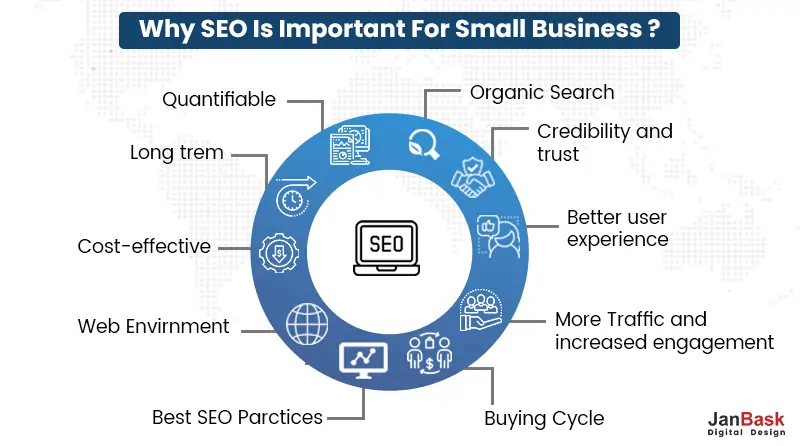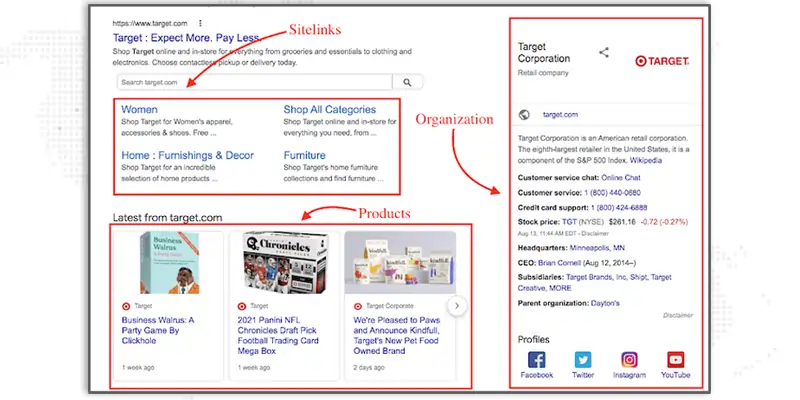
How do you make your online business stand out in the vast world of e-commerce, where countless online companies compete for attention?
Here comes the game-changer: Ecommerce SEO. E-commerce SEO is the critical component that raises your website's visibility in search engine results. It follows the most recent trends, enhancing rich snippets and strengthening the ties in search engine results. It's a digital alchemy that converts organic visitors into paying consumers and catapults your online presence into a wildfire of sales.
This blog will share some essential aspects of Best Practices in Ecommerce and provide a roadmap to optimize your online business efficiently. This guide will equip you with the information and best practices required to negotiate the complex SEO world for e-commerce websites and how professional e-commerce SEO services can help you build great E-commerce SEO Best Practices, whether you're an experienced e-commerce entrepreneur or just starting your digital company.
So, what are you waiting for? Let’s dive in!

Looking for eCommerce SEO Services?
E-commerce SEO, or e-commerce search engine optimization, improves an online store's website and product pages to increase its exposure and ranking in search engine results. The main goal of e-commerce SEO is to raise the online store's visibility, drive more organic (unpaid) traffic, and boost sales.
To optimize various areas of the online store for search engines, e-commerce SEO requires multiple techniques and strategies. This involves conducting keyword research to find relevant search terms, optimizing on-page components like meta tags and headings, enhancing site structure and navigation, creating distinctive and educational product descriptions, enhancing the user experience, addressing technical SEO issues, constructing high-quality backlinks, and utilizing content marketing and social media integration.

In today's fast-paced digital landscape, the success of your e-commerce business hinges on a well-executed SEO strategy. SEO is an essential factor for the success of any e-commerce business. It provides increased visibility, targeted traffic, enhanced user experience, competitive advantage, and long-term ROI. Optimizing your website for pertinent keywords can attract interested customers and increase conversion rates.
Consistently improving your website's SEO can ensure a steady stream of targeted traffic and a higher return on investment. Additionally, SEO allows you to differentiate your brand, highlight unique selling points, and establish authority in your industry. By prioritizing SEO e-commerce best practices in your e-commerce strategy, you unlock your company’s full potential, paving the way for sustainable growth and success.
SEO (Search Engine Optimization) has a global impact on the digital landscape, allowing businesses to expand internationally and driving economic growth. E-commerce SEO is important in attracting more organic traffic and driving higher conversions and revenue. It plays a crucial role in global information access, with 70-80% of users focusing on organic search results rather than paid ads.
It empowers businesses, facilitates trade beyond boundaries, standardizes digital marketing practices, enhances information accessibility, drives economic growth, fuels technological advancements, and promotes environmental sustainability.
When it comes to executing a successful E-commerce SEO strategy, there are numerous recommended approaches worth considering. These e commerce best practices aim to enhance the visibility of your online business and optimize it for search engine results.
Here are some essential best practices for ecommerce to incorporate into your E-commerce SEO strategy:
If you need help determining where to begin with on-site optimization for your e-commerce site to regulate e commerce best practices, your competitors can provide valuable insights. Significantly larger competitors have likely invested significant effort into optimizing their websites, and you can uncover many of their strategies by examining their websites.
To enhance your SEO e commerce best practices strategy, optimizing on-page elements like title tags, meta descriptions, and URLs is vital. These elements are crucial for conveying content relevance to search engines and potential visitors that visit your website.
Begin optimizing title tags, making them concise, compelling, and containing relevant keywords. Craft informative meta descriptions, capturing the attention of potential visitors. Persuasive meta-descriptions increase click-through rates and attract qualified traffic. This helps search engines understand your web pages.
Make sure to look into URL optimization. Ensure they are descriptive, concise, and contain relevant keywords. Well-optimized URLs provide valuable information to search engines and users before clicking the link. Ensure they are descriptive, concise, and include relevant keywords.
To establish a logical and intuitive site structure, incorporate clear categories and subcategories that align with your product offerings. This arrangement facilitates easy navigation and enables users to find relevant products easily. Ensure that each type accurately represents its contents and is well-defined.
Internal linking
Search engines can understand the relationships and hierarchy among web pages if you strategically interlink them. These internal links provide a clear path for search engines to effectively discover and index your content.
Ensure your site's navigation is intuitive and user-friendly. This will help in enhancing e-commerce best practices. Well-labeled navigation menus enable visitors to explore different sections of your website easily. Including a search bar enhances the browsing experience, allowing users to search for specific products or keywords directly. This optimization technique enhances user experience and enables search engines to crawl and understand your content effectively. Consequently, your e-commerce site gains better visibility and improved rankings in search engine results.

You can also improve your e-commerce best practices SEO strategy with schema markup, which offers search engines additional context and information about your products. This markup enhances the presentation of relevant details in search listings.
You can elevate your search results with rich snippets beyond standard links by implementing schema markup. These snippets highlight product ratings, pricing, availability, reviews, and more. Rich snippets capture users' attention and provide quick insights, boosting the likelihood of attracting qualified traffic to your e-commerce store.
To effectively implement schema markup, identify the appropriate schema types for your products, such as Product, Offer, Review, or AggregateRating, and utilize the schema.org vocabulary. Apply relevant properties and attributes to your product pages. This structured data assists search engines in comprehending and presenting your product information more effectively, benefiting both users and search engines and contributing to a more impactful e-commerce SEO strategy.
When it comes to running a successful e-commerce business, optimizing your product pages for Search Engine Optimization (SEO) is vital. Implementing e-commerce best practices for product page optimization can yield substantial benefits for your website. These practices can enhance your visibility in search engine results, drive higher volumes of organic traffic, and ultimately lead to increased conversions.
Besides optimizing product descriptions, there are several other key areas to focus on for comprehensive SEO e-commerce best practices.
Product Names
Firstly, optimize your product names by including relevant keywords and descriptive terms that accurately represent the product. This helps search engines understand your pages' content and improves your products' visibility in relevant search queries.
Image
Optimize your product images using descriptive file names and adding alt text. This allows search engines to interpret and index your pictures, potentially driving additional traffic through image search results.
Video
Video content can enhance user engagement and attract more visitors to your site. Consider incorporating videos to showcase your products. Optimize these videos by providing keyword-rich titles, descriptions, and tags.
Customer reviews
Encourage customer reviews for your products. Positive reviews build trust with potential customers and contribute to your search engine rankings. Ensure there is a mechanism for customers to leave reviews and display them prominently on your product pages.
FAQ section
Another aspect to consider is creating an FAQ section for your products. This content provides valuable information to potential customers and helps address their queries. Optimize your FAQ content by including relevant keywords and structuring it in a clear and organized format.
Optimizing your online store for mobile devices with the help of Mobile Apps Development Services is crucial to ensure the success of your ecommerce best practices SEO strategy. Adopt a responsive web design that adjusts your site's layout and content to different screen sizes, providing a seamless experience across devices.
Focus on fast-loading pages by optimizing images, minimizing code, and utilizing caching techniques. Design with the mobile user in mind, simplifying navigation and making buttons and links easily tappable.
Test your website on various mobile devices and conduct user testing to identify areas for improvement. Mobile optimization enhances user satisfaction and search engine rankings, contributing to a successful e-commerce SEO strategy.
One of the key factors in optimizing your e-commerce website is improving its loading speed which is another aspect of ecommerce best practices. A faster website provides a better user experience and is crucial to search engine rankings. Optimizing your ecommerce website's loading speed is essential for a better user experience and search engine rankings.
Optimize image sizes, enable caching, minify code, and use content delivery networks (CDNs) to achieve this. Regularly monitoring your site's speed with tools like Google PageSpeed Insights or GTmetrix can provide further insights and recommendations to optimize your site's performance. A fast-loading website satisfies users' expectations and signals to search engines that your site is well-optimized and user-friendly.
Prioritizing user experience is essential for the success of an online store. This can be achieved by designing an intuitive navigation system with clear and well-organized menus, clear and well-organized categories and subcategories, and prominently displayed calls-to-action (CTAs).
Optimize the website for easy browsing and searching by implementing filters, sorting options, and a robust search functionality, which will lead to better ecommerce best practices. Streamline the checkout process by simplifying form fields, providing clear instructions, and offering guest checkout options. Incorporate trust signals such as secure payment icons and customer reviews.
Regularly monitor and analyze user behavior using tools like heatmaps and user recordings to identify pain points and areas for improvement. By focusing on user experience, businesses can create a website that is easy to navigate, visually appealing, and optimized for seamless browsing and purchasing.
Social media integration can significantly enhance your online presence and boost your search engine rankings. By incorporating social media sharing buttons on your product pages, blog posts, and other relevant content, you can tap into the power of social signals to amplify your brand's visibility. Users sharing your content generate social movements such as likes, shares, and comments, indirectly impacting your search engine rankings.
Encourage users to engage with your content on social media by incorporating social calls-to-action and monitoring and analyzing social media metrics. You can also do this with the help of a Digital Marketing Agency like JanBask. Leveraging user-generated content, such as customer reviews and testimonials, on social media platforms can add authenticity and social proof to your brand, encouraging others to engage and share your content. By integrating social media into your ecommerce best practices, you can harness the power of social signals to boost your search engine rankings.
Indeed, keywords continue to hold significance. However, it's crucial not to cram your product titles and descriptions with keywords excessively. Instead, ensure their presence within the copy.
You must incorporate your primary keyword into the product headline, description, meta description, alternate image attributes, and subheadlines to enhance e commerce best practices. Additionally, include Latent Semantic Index (LSI) keywords intermittently. LSI keywords are closely related terms that aid Google in comprehending the context of your page.
Keywords should be your primary focus. Concentrate on long-tail keywords with low competition but strong intent. Use keyword research tools to find valuable keywords corresponding to your target audience's search queries. Specifically, analyze the keywords used on their home and most popular product pages.
Monitoring and analyzing the performance of your e-commerce website is essential for a successful SEO strategy. Use analytics tools like Google Analytics to monitor organic traffic, keyword rankings, conversion rates, and user engagement.
Analyze the sources of traffic, identify top-performing keywords, and track changes in traffic over time to determine which keywords and optimization strategies are driving the most organic traffic. Monitor keyword rankings to see how your website performs in search engine results pages and convert rates to optimize content accordingly.
Regularly monitoring and analyzing key metrics is essential for successful SEO efforts. This includes tracking the percentage of visitors who complete desired actions on your website, analyzing conversion rates by different traffic sources, landing pages, and user segments, and looking for opportunities to optimize underperforming pages, refine keyword targeting, improve site navigation, and enhance the overall user experience. By consistently monitoring and analyzing key metrics, you can stay informed about the effectiveness of your ecommerce best practices & SEO efforts and make data-driven decisions to enhance your website's performance.
Generating high-quality backlinks is essential for an effective ecommerce seo best practices & SEO strategy. Prioritize quality over quantity when seeking backlinks, and regularly monitor your backlink profile to identify any low-quality or spammy links. Focus on creating valuable and shareable content, guest blogging, collaborating with influencers and industry experts, and forming strategic partnerships.
Stay up-to-date with the latest ecommerce seo best practices and algorithm changes to ensure your backlink strategy remains effective. You can significantly enhance your website's authority, visibility, and search engine rankings by generating high-quality backlinks.
Monitoring and analyzing the performance of an Ecommerce SEO strategy is essential for its success. Utilizing analytics tools such as Google Analytics can help monitor important SEO metrics such as organic traffic, keyword rankings, conversion rates, and bounce rates.
High bounce rates indicate your website's design, content, or user experience issues. Analyze pages with high bounce rates and make improvements to engage visitors and encourage them to explore further. By regularly tracking key metrics and analyzing the data, businesses can gain valuable insights into the effectiveness of their optimization efforts.
Make data-driven decisions to adapt your E-commerce SEO strategy and implement changes that can lead to better results. Continuously monitor and analyze your SEO performance, make data-driven adjustments, and be patient as you work towards improving your website's visibility and driving organic traffic. Stay informed about the latest SEO trends, algorithm updates, and best practices in the industry.
Understanding the art of SEO is essential to stand out from the competition and achieve great conversions in the huge e-commerce market, where various firms compete for the spotlight. You may create the conditions for the success of your online business by applying the excellent SEO practices covered in this blog. Each technique can boost your conversions, from thorough keyword research to website optimization, from developing engaging material to making the most of social media.
Remember that SEO is a continuous effort rather than a one-time endeavor. Put up with the newest trends and algorithm updates, alter your strategy accordingly, and always put customers at the forefront of your optimization efforts. You may start a positive feedback loop of better exposure, more visitors, and, eventually, a spike in conversions by consistently improving your e-commerce SEO best practices.
To learn more, contact JanBask Digital Design. We specialize in providing high-quality Ecommerce SEO website development services to our clients.
Interested in our eCommerce SEO Services?

1. How to use SEO for e-commerce?
Using ecommerce SEO best practices for e-commerce boosts visibility and organic traffic. SEO is an ongoing process that requires patience, consistency, and adaptation to changing algorithms and user behavior. Steps to utilize SEO effectively include keyword research, on-page optimization, site structure and navigation, URL structure, mobile optimization, site speed improvement, user-generated reviews, implementing rich snippets, internal linking, backlink building, and monitoring and analyzing performance.
2. What are the top 5 SEO strategies?
Here are five effective ecommerce SEO best practice that can help improve your website's visibility and organic rankings:
3. Is SEO good for e-commerce?
SEO is highly beneficial for e-commerce websites as it improves visibility, attracts targeted traffic, offers cost-effective marketing, enhances user experience, provides long-term results, builds credibility and trust, and gives a competitive advantage. Ecommerce SEO best practice is a continuous process that requires consistent effort and monitoring for optimal performance.
4. What is the best e-commerce website structure for SEO?
The best e-commerce website structure for SEO involves creating a user-friendly and search engine-friendly architecture with a clear hierarchy and flat design. Use SEO-friendly URLs, implement breadcrumbs, and optimize internal linking. Generate an XML sitemap, optimize the user experience and mobile-friendliness, improve site speed, and implement schema markup. Adapt the structure based on your website's size and complexity, prioritize user experience, and regularly monitor and adjust based on best practices in ecommerce
5. What is the difference between SEO and eCommerce SEO?
SEO and eCommerce SEO have similarities in enhancing website visibility and attracting organic traffic. However, there are distinct differences between the two:
eCommerce SEO is a specialized subset of SEO tailored to optimize online stores for visibility, conversions, and sales. While there are similarities, best practices in ecommerce require specific strategies to address the unique challenges of online selling.
R
I need ecommerce SEO services for my ecommerce store. How much it will cost to outsource SEO services that all generally cover under seo package.